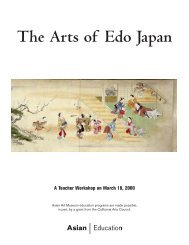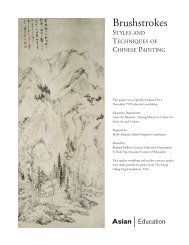Sacred Arts of Tibet (.pdf) - Asian Art Museum | Education
Sacred Arts of Tibet (.pdf) - Asian Art Museum | Education
Sacred Arts of Tibet (.pdf) - Asian Art Museum | Education
Create successful ePaper yourself
Turn your PDF publications into a flip-book with our unique Google optimized e-Paper software.
Why is a Mongolian artwork included in a packet on <strong>Tibet</strong>?<br />
<strong>Sacred</strong> <strong><strong>Art</strong>s</strong> <strong>of</strong> <strong>Tibet</strong><br />
We have included this piece for two practical reasons: 1) the museum’s <strong>Tibet</strong>an collection contains no<br />
sculpture <strong>of</strong> Shakyamuni, the founder <strong>of</strong> Buddhism, who is a fundamental starting point for any discussion<br />
on Buddhism, and 2) its style is very similar to what would be found in <strong>Tibet</strong> as it was taught to<br />
Mongolian artists by <strong>Tibet</strong>an artists, and follows the strict and detailed standards <strong>of</strong> traditional <strong>Tibet</strong>an<br />
Buddhist iconography.<br />
The bottom <strong>of</strong> this sculpture is<br />
inscribed with English? Why?<br />
A steel plate placed on top <strong>of</strong> the double thunderbolt<br />
design under the base is inscribed with<br />
the following: “ J. Johnson, Quarter Master,<br />
99th Regiment, China Campaign, 1860.”<br />
Quarter Master Johnson was part <strong>of</strong> the Allied<br />
troops that occupied Beijing and destroyed the<br />
summer palace (Yuanming Yuan). There is no<br />
doubt this piece was taken at that time.<br />
Discussion Points/Teaching<br />
Suggestions:<br />
Bottom view <strong>of</strong> Shakyamuni statue, 1994.131<br />
1) How did Buddha’s teachings spread?<br />
Examine maps showing terrain and cities <strong>of</strong> Asia to find Varanasi in India (near where the Buddha gave<br />
his first sermon). Discuss or research the following questions:<br />
•How was it possible that his words traveled over the high Himalayan mountains to <strong>Tibet</strong>?<br />
•Where else did Buddhism travel to? (virtually all <strong>of</strong> Asia and, recently, the US and Europe)<br />
•How did it get there? (discuss trade routes—overland and by sea, immigration, foreign occupation<br />
causing refugees to flee to other countries, pilgrimage, traveling monks inbound and outbound<br />
from India, the transmission <strong>of</strong> ideas through texts translated into many languages, the impact <strong>of</strong><br />
the Buddhist arts that were traded in sharing <strong>of</strong> ideas, the popularity <strong>of</strong> Buddhism in contemporary<br />
western society, etc.)<br />
•What other kinds <strong>of</strong> things were exchanged through trade? (writing, technologies, silk, metals, language,<br />
etc.)<br />
•Consider ways that trade and immigration in the US has changed American culture over the past<br />
200 years.<br />
•How has China’s invasion <strong>of</strong> <strong>Tibet</strong> changed <strong>Tibet</strong> and India (where a large exile community resides)?<br />
22<br />
<strong>Asian</strong> <strong>Art</strong> <strong>Museum</strong>
















